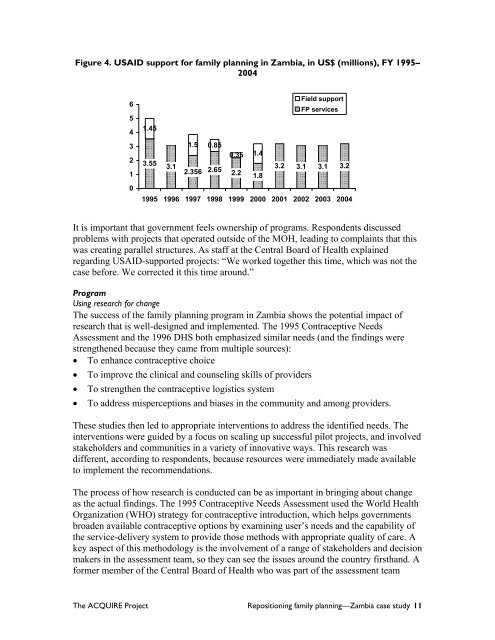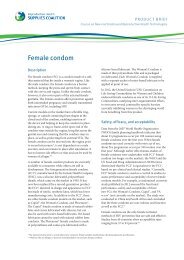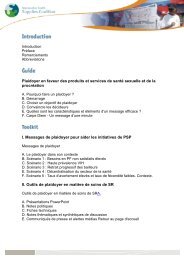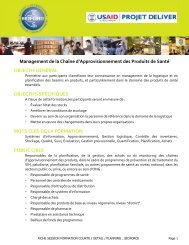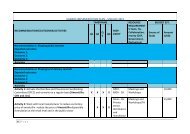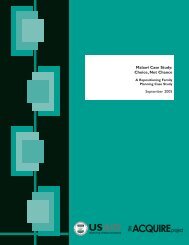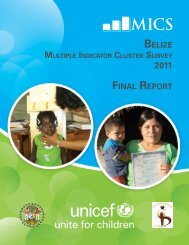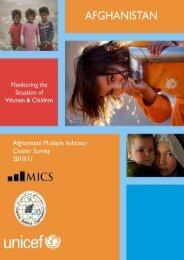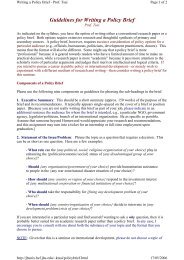Zambia Case Study: Ready for Change - Reproductive Health ...
Zambia Case Study: Ready for Change - Reproductive Health ...
Zambia Case Study: Ready for Change - Reproductive Health ...
You also want an ePaper? Increase the reach of your titles
YUMPU automatically turns print PDFs into web optimized ePapers that Google loves.
Figure 4. USAID support <strong>for</strong> family planning in <strong>Zambia</strong>, in US$ (millions), FY 1995–<br />
2004<br />
6<br />
5<br />
4<br />
1.45<br />
Field support<br />
FP services<br />
3<br />
2<br />
1<br />
3.55<br />
3.1<br />
1.5 0.85<br />
0.35 1.4<br />
2.356 2.65 2.2 1.8<br />
3.2 3.1 3.1 3.2<br />
0<br />
1995 1996 1997 1998 1999 2000 2001 2002 2003 2004<br />
It is important that government feels ownership of programs. Respondents discussed<br />
problems with projects that operated outside of the MOH, leading to complaints that this<br />
was creating parallel structures. As staff at the Central Board of <strong>Health</strong> explained<br />
regarding USAID-supported projects: “We worked together this time, which was not the<br />
case be<strong>for</strong>e. We corrected it this time around.”<br />
Program<br />
Using research <strong>for</strong> change<br />
The success of the family planning program in <strong>Zambia</strong> shows the potential impact of<br />
research that is well-designed and implemented. The 1995 Contraceptive Needs<br />
Assessment and the 1996 DHS both emphasized similar needs (and the findings were<br />
strengthened because they came from multiple sources):<br />
• To enhance contraceptive choice<br />
• To improve the clinical and counseling skills of providers<br />
• To strengthen the contraceptive logistics system<br />
• To address misperceptions and biases in the community and among providers.<br />
These studies then led to appropriate interventions to address the identified needs. The<br />
interventions were guided by a focus on scaling up successful pilot projects, and involved<br />
stakeholders and communities in a variety of innovative ways. This research was<br />
different, according to respondents, because resources were immediately made available<br />
to implement the recommendations.<br />
The process of how research is conducted can be as important in bringing about change<br />
as the actual findings. The 1995 Contraceptive Needs Assessment used the World <strong>Health</strong><br />
Organization (WHO) strategy <strong>for</strong> contraceptive introduction, which helps governments<br />
broaden available contraceptive options by examining user’s needs and the capability of<br />
the service-delivery system to provide those methods with appropriate quality of care. A<br />
key aspect of this methodology is the involvement of a range of stakeholders and decision<br />
makers in the assessment team, so they can see the issues around the country firsthand. A<br />
<strong>for</strong>mer member of the Central Board of <strong>Health</strong> who was part of the assessment team<br />
The ACQUIRE Project Repositioning family planning—<strong>Zambia</strong> case study 11


